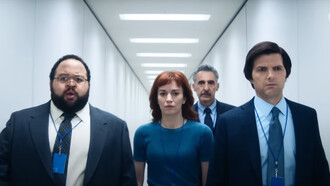As the final credits of Oppenheimer rolled in the dimly lit theater, I found myself slowly sinking into the plush seat, the echoes of Ludwig Goransson’s haunting score still reverberating through the walls. The presence of Christopher Nolan’s name on the screen left a lasting impression as if his very essence had seeped into the celluloid. Gwendolyn Brooks’ poignant poem, penned for the Chicago Picasso, found its way into my thoughts, its words encapsulating the enigmatic relationship between man and art.
Does man love Art? Man visits art but squirms. Art hurts. Art urges voyages. And it is easier to stay at home, the nice beer ready.
Contemplating the audience surrounding me, I wondered how many truly grasped the essence of Oppenheimer, how many were here for more than the allure of familiar actors or the promise of intellectual engagement. Cillian Murphy’s magnetic presence, honed through Peaky Blinders, may have drawn some, their admiration fueled by the way smoke gracefully billowed from his mouth in screen-time swagger. Others, lured by the sheer reputation of Christopher Nolan, sought the glamour of being part of something profoundly cerebral. But amidst the crowd, I questioned how many were prepared to appreciate the film’s subtlety, its intricate beauty.
In a moment both poignant and powerful, Robert Oppenheimer stands before the audience to deliver a speech in the aftermath of the harrowing bombings of Hiroshima and Nagasaki. Behind him, the backdrop quivers ever so slightly, a haunting reflection of the turmoil within his conscience. As he hesitates, taking a thoughtful pause before he speaks, his words ring with an unexpected firmness, yet a discerning eye can sense the incongruity. It is as though he utters the very opposite of what he truly feels and thinks in that very moment.
As he ascends the stairs, the weight of his words still hanging heavy in the air, the audience offers their congratulatory pats on his back. But amidst the facade of achievement, he pauses on a step, his gaze slowly drifting downward to see that he has unwittingly stepped upon the remains of a burnt corpse, now reduced to mere ashes. In this fleeting instant, the depth of the inner conflict he carries becomes profoundly evident. This meticulously crafted scene brims with minute details, inviting contemplation into the complexities of human emotion and the moral dilemmas that arise from wielding great power.
However, I find myself pondering how many in the theater truly grasped the depth of this portrayal. The subtlety of Oppenheimer’s internal strife, cleverly masked by his outward facade, demands the viewer’s keen attention and empathy.
Recently, I stumbled upon a disheartening revelation on the internet – the movie Barbie had raked in a staggering $337 million at the box office, while Oppenheimer, a film of profound artistry, earned $174.2 million. Though not entirely surprising, the statistics served as a painful reminder of the imbalance between mass appeal and genuine appreciation for art.
Brooks’ powerful words reverberated in my mind as I contemplated the stark contrast between the popularity of Barbie and the profound impact of Oppenheimer. It is true that Barbie represents the art that lies comfortably within the realm of familiarity – a world they are accustomed to, one they can easily understand and relate to. It offers the safety of predictability, where the storyline is neatly wrapped in a glossy package, lacking the capacity to evoke deep discomfort or challenge their perspectives.
On the other hand, Oppenheimer stands as an art form that demands more from its audience. It beckons viewers to step out of their comfort zones, to confront the uncomfortable truths it presents. The movie takes us on a transformative journey, one that makes us delve deep into the recesses of our minds, not necessarily where we would choose to go.
Brooks implores,
But we must cook ourselves and style ourselves for Art, who is a requiring courtesan.
In these lines lies the essence of understanding Oppenheimer. To truly appreciate its brilliance, we must be willing to mold our vision, to cook ourselves intellectually and emotionally, preparing to engage with the art in all its complexity. Just as a courtesan demands more than passive admiration, Oppenheimer requires active participation from its audience.
Barbie, with its glitzy allure and predictable narrative, offers a convenient escape, while Oppenheimer beckons us to confront the discomforts of reality and the moral ambiguity of human actions. It is not the kind of art that can be simply watched for entertainment; it challenges us, shakes us from complacency, and forces us to look within ourselves.
While Barbie may draw the masses with its familiarity and simplicity, Oppenheimer calls to those willing to embrace art’s voyage, to venture into uncharted territories of thought and emotion. It is in this willingness to embrace the discomfort, to grapple with the complexities, that true appreciation for Oppenheimer, and art in its purest form, emerges. It is in this confrontation with discomfort that art leaves an indelible mark upon our souls, forever shaping our perceptions and enriching our understanding of the human experience.















